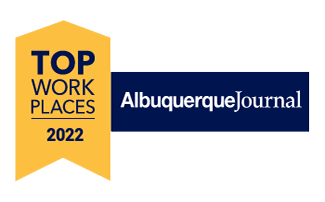
Outreach Services Birth-22
History
As part of its commitment to continuous improvement in educating students with visual impairment, NMSBVI has partnered with a variety of early intervention organizations, educational institutions, families and other stakeholders through the years to develop programs that are far-reaching throughout the state and that address the fluctuating needs of students who are blind/visually impaired and their families.
Beginning in July 2006, NMSBVI moved its Outreach Program for school-aged students to Albuquerque and joined with the Early Childhood Program to create a solid, birth to twenty-two program, statewide, to serve New Mexico children. The program is made up of the Birth to Three year old program; a preschool in Albuquerque that has operated since 1974; and the School-aged program.
In a partnership with New Mexico State University, a personnel preparation program available to any educator in the state who desires to gain the skills necessary to teach students who are blind or to serve as an orientation and mobility instructor now exists in New Mexico.
Through the legislative process and in collaboration with Public Education Department, licensure for Teachers of the Visually Impaired and an Orientation and Mobility license are now required by teachers serving students who are blind/VI. This helps ensure that all children needing these services can have access to a highly qualified teacher.
Through a partnership with the Department of Health, New Mexico families statewide receive home-based services for their infants and toddlers, aged birth to three who are or who are at risk for a diagnosis of visual impairment.
The Outreach Department of NMSBVI is designed to support public, private and BIE schools who serve students who are blind/visually impaired.
Within that partnership, NMSBVI can help in several ways:
2. If a New Mexico school district would like to have their own Teacher of the Visually Impaired and/or Orientation and Mobility Specialist, NMSBVI
provides scholarships to interested district educators to complete the required coursework to become licensed. Experienced teachers of the visually
impaired (TVI) as well as trained orientation and mobility (O&M) specialists are available from NMSBVI to mentor, support, answer questions and help
an educator gain the experience needed to work confidently in the field. (see Mentorship Support below for more information)
3. If a school district is too small or does not have enough students in need of a TVI or O&M instructor to warrant their own TVI or O&M, NMSBVI
can help districts build a consortium to explore the possibility of sharing a TVI or O&M instructor. A list of private contractors may also be
available from NMSBVI.
4. NMSBVI staff is available to complete functional vision evaluations, learning media assessments and orientation and mobility assessments in
school districts as needed. Through this assessment process, NMSBVI staff can recommend needed services.
5. Consultation on any child with a visual impairment; assistance at IEPs
6. Training related to specific students or to visual impairment issues is available to district personnel.
7. The Alamogordo campus and the Outreach Department are working together to develop short-term placement opportunities for students that
specifically target skills not covered in regular day to day schooling. The Outreach Department can help coordinate a placement on the residential
campus in Alamogordo to help
8. The Outreach department can support your district to register your students through the American Printing House for the Blind registry and the
Instructional Resource Center supplemental registry so that vision specific materials may be ordered.
9. Training (see below for opportunities)
10. Low Vision Clinic (see below for information)
11. Technology support. NMSBVI has a mission to develop, implement and share comprehensive and innovative approaches for
educating students. Technology specific to students who are blind or visually impaired is a very important part of that approach. NMSBVI provides an
Assistive Technology Consultant to work with teachers and students who are blind or visually impaired in school districts. The Consultant provides
information and training on the latest technology that supports educational accessibility for New Mexico’s students who are blind or visually
impaired. In addition, NMSBVI has a technology Lending Library, from which school districts may borrow equipment prior to purchase. Appropriate
technology is selected for a student by the assistive technology consultant following assessment of a student.
Mentorship Support Services
The National Commission on Teaching and America’s Future has calculated that nearly a third of all new teachers leave the profession after just three years, and that after five years almost half the new teachers have left the profession (46%). The National Commission on Teaching and America’s Future finds this to be internationally true. (No Dream Denied; A Pledge to America’s Children, January, 2003) The reason? Isolation, frustration, lack of professional networking, and the lack of confidence in the required knowledge base; new professionals in education are expected to do the same job, same tasks, and same duties as those of the 20-year veteran. In an effort to change those statistics, NMSBVI has developed an extensive Mentorship Support Services Program in partnership with New Mexico State University’s Vision Impairment Program. Teachers enrolled in NMSU’s program to become a teacher of the visually impaired or an orientation and mobility instructor are assigned a mentor who will support them in their district as they develop the skills to become effective TVIs/O&M specialists. Mentors are assigned during the first university class.
In addition, other teachers of the visually impaired or orientation and mobility instructors can find mentor support through NMSBVI. Through these collaborative mentorships, teachers and O&M specialists find resources, support, and networking opportunities to ease the stresses of this very specialized job.
Training & Education


